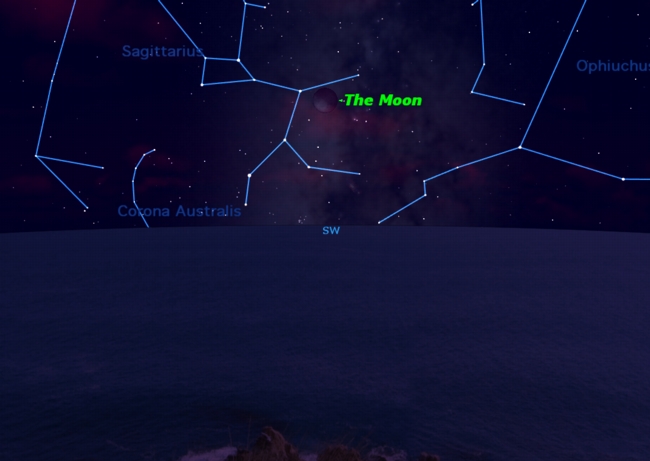Full Moon on Saturday Includes Partial Eclipse

Thefull moon of June will rise over Earth on Saturday, only to fall into a partiallunar eclipse as it passes through part of our planet's shadow.
Knownas the Flower moon in English, the June full moon will occur at 7:30 a.m. EDT(1130 GMT) on Saturday, June 26, nearly two hours after it is partiallyeclipsed. (Thisgraphic shows where to spot the full moon early Saturday morning.)
Becauseof the mechanicsof the moon, it will set around 5:30 a.m. EDT (0930 GMT), so observers inthe western and central parts of North America will have a better view ofJune's full moon, and the partial lunar eclipse that precedes it.
Thefull moon will be located in the constellation Sagittarius, very close to thesouthernmost point in its monthly journey around the Earth.
Asa result, the moon spends less time than average above the horizon and nevergets very far above the horizon, as seen from the Northern Hemisphere.
Thepartial lunar eclipse will obscure just over half of the full moon. SPACE.comskywatching columnist Joe Rao said in his guideto the June 26 lunar eclipse that the event should last for several hours(2:50 a.m. to 6:25 a.m. Pacific Time).
Moon myths andmysteries
Breaking space news, the latest updates on rocket launches, skywatching events and more!
Weatherpermitting, the moon is visible most nights at some point and is the brightestobject in the night sky. It is also visible in daylight much of the month,though most modern humans may be unaware of it.
Here'show it works:
Themoon is a sphere, lit from varying angles by the sun. As it moves around theEarth in its orbit, it goes through a series of phases from new moon, when themoon lies on or near a line between Earth and sun; first quarter, when lit fromone side; full moon, when lit by the sun directly behind the Earth; and thirdquarter, lit from the other side. [More: How MoonPhases Work]
Afull moon is the most striking of the lunar phases. At this time, a seeminglyhuge moon rising in the east, fully illuminated, just as the sun is setting inthe west.
Thelarge size of the full moon is actually an optical illusion, known as ?the moonillusion.? It is caused, some scientists think, by our mind?s attempt to makesense of the moon in relation to earthly objects on the horizon. In fact, thefull moon on the horizon is no larger than the moon at any other time orlocation.
Youcan verify the moon illusion yourself by holding a small object, such as apencil eraser at arm's length and compare its size to that of the rising moon.
Thengo back out a couple hours later, when the moon is higher and seems smaller,and make the same comparison to the eraser. Alternately, you can take twopictures of the moon, with your camera at the same settings, then print andcompare them.
Guide to June's fullmoon
Theexact time of a full moon is determined strictly by the geometry of the sun,Earth, and moon: all three fall in a straight line with the Earth in themiddle. This is an instantaneous event, and happens at the same instanteverywhere in the world.
InJune's case, the event will occur after the moon has set in eastern NorthAmerica. These circumstances change as you move across the continent.
InSan Francisco, the full moon occurs at 4:30 a.m. with the moon 12 degrees abovethe horizon. There, the partial lunar eclipse will be a fine sight up and downthe west coast of North America.
Butin England, June's full moon occurs at 12:30 p.m. British Summer Time, with themoon far below the horizon. The moon itself is quite indifferent to where onEarth people are observing it from.
What's in a moonname?
Likethe full moon of every month, June's comes with a host of different names allaimed at chronicling the monthly event. Various peoples around the world gavespecial namesto the full moons throughout the year as a simple way of recognizing thepassage of time.
Thebest known of these names are those used in the English language, but otherwell known naming systems are used by the Algonquian peoples of northeasternNorth America, the Hindus of India, and the widespread Buddhist religion.
Inaddition to its Flower moon moniker, June's full moon also known as thestrawberry moon in Algonquian, Wat Poornima in Hindi, and Poson Poya in the Sinhala Buddhist tradition.
Itis also known as honey moon, rose moon, hot moon, and planting moon.
- Photos: Lunar Eclipse Wows the World
- Top 10 Amazing Moon Facts, Moon Gallery
- Beginner Astrophotography Telescopes
This article wasprovided to SPACE.com by StarryNight Education, the leader in space science curriculum solutions.

Geoff Gaherty was Space.com's Night Sky columnist and in partnership with Starry Night software and a dedicated amateur astronomer who sought to share the wonders of the night sky with the world. Based in Canada, Geoff studied mathematics and physics at McGill University and earned a Ph.D. in anthropology from the University of Toronto, all while pursuing a passion for the night sky and serving as an astronomy communicator. He credited a partial solar eclipse observed in 1946 (at age 5) and his 1957 sighting of the Comet Arend-Roland as a teenager for sparking his interest in amateur astronomy. In 2008, Geoff won the Chant Medal from the Royal Astronomical Society of Canada, an award given to a Canadian amateur astronomer in recognition of their lifetime achievements. Sadly, Geoff passed away July 7, 2016 due to complications from a kidney transplant, but his legacy continues at Starry Night.
